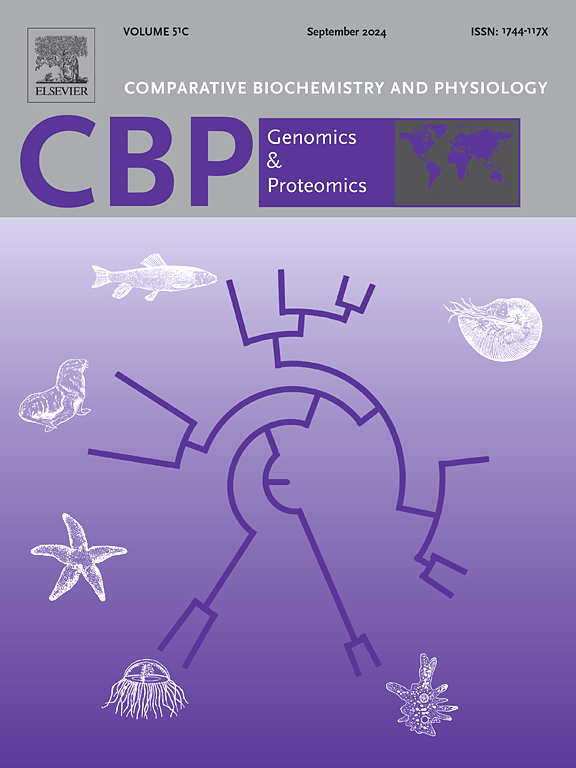生化指标、组织学观察和转录组测序揭示了大口黑鲈(Micropterus salmoides)对运输胁迫的响应机制
IF 2.2
2区 生物学
Q4 BIOCHEMISTRY & MOLECULAR BIOLOGY
Comparative Biochemistry and Physiology D-Genomics & Proteomics
Pub Date : 2025-04-17
DOI:10.1016/j.cbd.2025.101514
引用次数: 0
摘要
本研究模拟了大口黑鲈运输应激过程中肠道组织结构、氧化应激、细胞凋亡和转录组水平的变化。结果表明:随着运输时间的延长,大口黑鲈血清皮质醇和乳酸水平显著升高,葡萄糖含量在运输8 h后达到峰值。8 h和12 h后,4 h时肠道活性氧、超氧化物歧化酶、丙二醛和过氧化脂质含量均显著高于对照组和应激组,肠组织粘膜脱落较多,水肿,肠绒毛高度和密度显著降低。在转运胁迫0 h、8 h和12 h后进一步分析差异表达基因。与p53信号通路相关的基因(igfbp1a、ccnb1、cdk1和igfbp6b)和凋亡相关的基因(bcl2111、parp3、pik3r1、fadd、aifm1和lmnb1)存在显著差异。结合应激后肠细胞凋亡数量的增加,表明运输应激对肠细胞凋亡有实质性影响。应激组的肠道抗氧化活性和组织结构在应激8 h后恢复到应激前水平;然而,这些参数在运输12小时后恢复7天后没有恢复到预应力水平。这一发现进一步证明了长期运输应激通过p53信号通路诱导大口黑鲈肠细胞凋亡和组织损伤。本文章由计算机程序翻译,如有差异,请以英文原文为准。

Biochemical indices, histological observations and transcriptome sequencing reveal the response mechanism of largemouth bass (Micropterus salmoides) to transport stress
In this study, transport conditions were simulated to investigate changes in intestinal tissue structure, oxidative stress, apoptosis and transcriptome levels during transport stress of largemouth bass (Micropterus salmoides). The results showed that the serum cortisol and lactic acid levels in largemouth bass significantly increased with increasing transport time, and the glucose content peaked after 8 h of transport. After 8 h and 12 h, the Reactive oxygen species, superoxide dismutase, malondialdehyde, and lipid peroxide contents in the intestine were significantly higher than those in the control group and the stressed group at 4 h. Additionally, more of the mucous membrane of intestinal tissue was exfoliated, resulting in edema, and the intestinal villi height and density significantly decreased. The differentially expressed genes were further analyzed after 0 h, 8 h, and 12 h of transport stress. There were significant differences in genes associated with the p53 signaling pathway (igfbp1a, ccnb1, cdk1, and igfbp6b) and apoptosis (bcl2l11, parp3, pik3r1, fadd, aifm1, and lmnb1). Combined with the increasing amount of apoptotic cells after stress, these results indicated that transport stress had a substantial effect on intestinal cell apoptosis. The intestinal antioxidant activity and tissue structure of the stressed groups recovered to the pre-stress level after 7 d of recovery from 8 h of transport; however, these parameters did not return to pre-stress levels after 7 d of recovery from 12 h of transport. This finding further demonstrated that long-term transport stress induced apoptosis and tissue damage in the largemouth bass intestine through p53 signaling.
求助全文
通过发布文献求助,成功后即可免费获取论文全文。
去求助
来源期刊
CiteScore
5.10
自引率
3.30%
发文量
69
审稿时长
33 days
期刊介绍:
Comparative Biochemistry & Physiology (CBP) publishes papers in comparative, environmental and evolutionary physiology.
Part D: Genomics and Proteomics (CBPD), focuses on “omics” approaches to physiology, including comparative and functional genomics, metagenomics, transcriptomics, proteomics, metabolomics, and lipidomics. Most studies employ “omics” and/or system biology to test specific hypotheses about molecular and biochemical mechanisms underlying physiological responses to the environment. We encourage papers that address fundamental questions in comparative physiology and biochemistry rather than studies with a focus that is purely technical, methodological or descriptive in nature.

 求助内容:
求助内容: 应助结果提醒方式:
应助结果提醒方式:


